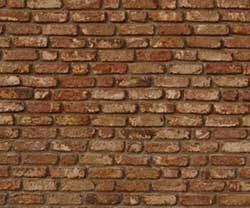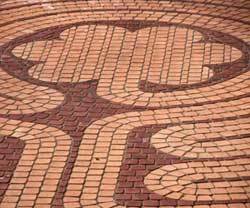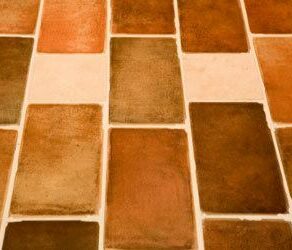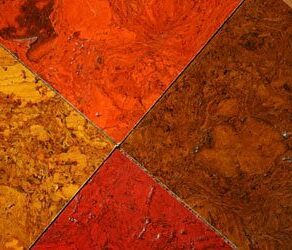
Crystal asked: What is the best way to clean and polish old brick flooring and what solutions should be used?
Brick flooring is versatile, durable and can be placed in various patterns and designs to be both elegant as well as practical. The upside is the beautiful strong floor you have placed in your home will last you for many years. The other side is the care that brick requires. Brick is very porous and quickly absorbs dirt and grime, requiring frequent cleaning, sealing and polishing.
General Maintenance Cleaning
You Will Need:
- Vinegar
- Water
- Bucket
- Microfiber mop
- A second microfiber mop (optional)
- Microfiber cloth (optional)
Steps for Day-To-Day Cleaning:
*This cleaning method is intended for brick flooring that is already sealed. If it is not, it will be necessary to apply a sealant and allow it to set prior to cleaning with any solutions.
- Begin by sweeping and either dry mopping or vacuuming the entire area to remove any loose dirt and dust.
- Make a weak vinegar/water solution with one part vinegar and at least 15 parts water in the bucket.
- Dip the mop into the water and wring it out completely. Avoid allowing water to sit on top of the brick as it will cause streaks and spots when it dries.
- Use the mop to clean the entire floor, reapply the solution as necessary.
- When the entire floor has been cleaned, it is helpful to go over the floor again with a second, dry mop or a dry microfiber cloth to buff the floor and wipe up any remaining liquids. This will remove any areas with streaks or smudges as well.
- This method allows the floor to be cleaned and shined with one application, saving you a lot of time.
Quick Stripping and Resealing/Waxing
You Will Need:
- Clear ammonia
- All purpose cleaner
- Cold water
- Bucket
- Rubber gloves
- Sponge mop
- Acrylic floor wax (self-sealing)
Steps for Stripping and Waxing:
*The ammonia in this solution strips the floor with each use. The self-sealing wax allows you to skip the step of applying a separate sealant. It is not as effective as a thorough stripping and resealing, but it works well for a quick touch-up.
**Always work in a well-ventilated area with rubber gloves for protection.
- Begin by sweeping and either dry mopping or vacuuming the entire area to remove any loose dirt and dust.
- In the bucket, combine 1 cup ammonia, ¼ cup of all purpose cleaner and 8 cups of cool/cold water.
- Use the mop to apply the solution to the floor.
- Scrub dirty areas well to remove dirt prior to applying any sealants as they will not be accessible once the floor is sealed.
- Rinse well with clean, cold water.
- Allow the floor to dry completely.
- Apply the floor wax following the manufacturer’s instructions. Two thin coats may be necessary. If you choose a wax that is self-sealing, it will not be necessary to apply a separate sealer.
What Can & Can’t Be Used on Brick Floors
- Do NOT use acids, strong soaps or abrasives on brick floors.
- Solvent-based polish CAN be applied over water-based polish.
- Water-based polish CANNOT be applied over solvent-based polish.
- Ensure all sealers are designed for brick, basic lacquers and varnishes are not enough.
Additional Tips and Ideas
- AquaMix carries a wide variety of cleaners and sealers that are safe to use on brick flooring.
- If a solvent-based wax is applied to the floor, a sealant is required as well.
- Wax build-up is a problem with water-based polishes and will need to be stripped periodically.
- Reseal your floor each year to maintain the seal.
- If applying a wax over a sealant, it may be helpful to test a small area first. Some waxes will leave a streaky finish. One way to avoid this is try buffing the area with a microfiber mop or microfiber cloth.
- For lighter cleanings on a sealed floor, just a quick mopping with plain water will do the job.







Would Pine-Sol used twice monthly over a 12 year period cause my red brick floor to fade into a sandy color and the concrete to fluoresce? I would really appreciate an answer to this question.
It’s hard to find good advice about cleaning brick floors. The ammonia is working well to clean it! Next – the wax!
I work in a coffee shop that is in a basement of an old building. It has a brick floor, just like the bricks you would see outside on the sidewalk. What could we use to get it clean and keep it clean?
I just put in brick flooring. My mother has them as well, and used paste wax to seal them and maintain the floors. Is this recommended, or should I use a sealer?
I’m single and have an old brick floor in my industrial loft. I’d like to use a quality wax or polish that is easy to apply. Is there a type which doesn’t have to be stripped before rewaxing or polishing? A type that will be easy for me to apply and, if necessary, take off; will act as a nice sealant. Ron
Our house was built in 1975 with brick floors throughout. The kitchen floor, however, has a lot of ‘grease’ between the bricks. The builder did not seal the bricks and so…you can imagine the problem. I have been washing it with a sponge mop with soap and water. Certainly NOT enough.
What is your suggestion for a better clean? Will AMMONIA really…do it?
Thank you. I await with baited breath!!!
Eugenia,
This is the article that you need: How to Clean Brick. You can try working your way through the solutions on that article and hopefully one will be the key to removing your specific stains.
If none of those solutions work, there is a section in the article How to Clean Exterior Brick on removing oil stains from brick. Since that is such a strong cleaning method, you could test that solution on a small hidden area of your floor first to see how well it works before using it on a more prominent area of the floor.
I just scratched my brick floor moving furniture. How do I remove the scratches?
Kristie,
The scratch might come off just by cleaning the brick. If not, you may need to buff them out with a scrub brush, and if that doesn’t work, a wire brush. Be gentle when buffing though or you might remove the brick face, changing the color of the brick. If you do have a color change, you can repair it by soaking a loose brick in water, then rubbing it on the brick you need to repair to transfer the color.
Source: AllExperts – Masonry/Brick Laying: repairing scratches on brick
Source: Never Paint Again! – How to Restore Minor Brickwork Damage
My cleaning lady used some sort of multi cleaner on my brick floor. It is dull and lackluster. How can I get my old floor back?
Phyllis,
Try mopping the floor with a little dish liquid. That will remove the residue from the other cleaner that is causing it to look dull. Be sure to rinse thoroughly as well to fully remove the residue.
Looking for glossy finish for my newly laid brick tile floor. Kindly help me.
Rgds.
Vineat
Vineat,
Apply a sealer or finish on the floor that is “wet-look” or “high-gloss”. There are a variety available at major hardware stores. Good luck!
Source: Hunker – How To Make Brick Glossy
Source: Behr- Behr Premium Wet-Look Sealer